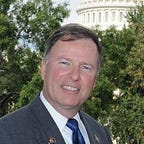The Story Behind the Pikes Peak National Veterans Cemetery
“I have been working on this project since my first day in office.”
What a great day, what an exciting day for our community. We finally have not just the place, the design, the funding, but now a name for the national veterans’ cemetery here in the Southern Colorado area.
Even before I was elected to office in 2006, I vowed that one of my missions in Congress would be to work for a national veterans’ cemetery for Southern Colorado. We had one way out on the Eastern plains, and that’s really not a viable option for most people out on the Front Range. And we have Ft. Logan in Denver. Ft. Logan is becoming more and more filled with people being buried there, and it does not have a long projected life. Plus, it’s hard to get there. And if you’re elderly fighting the traffic or bad weather, it’s maybe impossible.
So the first day in office, I turned in my bill request. I worked with John Salazar, who was in the majority. I was a freshman in the minority, sort of the lowest of the low, you might say. John Salazar Pueblo County andand I came to an agreement: he had wanted a veterans’ cemetery in Pueblo. So we talked it over, and he recognized that we have so many veterans here in El Paso County that as long as we agreed to put it in Southern El Paso County so that people from Pueblo can access it, he would go along with it. We would work together arm in arm. That’s what we’ve done ever since.
In 2008, we had another breakthrough. I got on the Veterans’ Affairs Committee right from my first day in office. That was a meaningful, important thing to me. And I got on the Subcommittee having to do with cemeteries, the Disability and Memorial Affairs Subcommittee.
On the subcommittee, we brought out William Turk to come and visit and have a hearing here in El Paso County. And as luck or Providence would have it, a blizzard hit the day he got here. He almost didn’t get to the hearing on time because of the bad weather. So he saw for himself how bad weather can keep people from the Pikes Peak region from going up to Denver. It was impressed deeply on him in a first-hand personal kind of way. He saw that we qualified, and we should have a veterans’ cemetery here in El Paso County. He and the VA were on board after that.
Now it finally got into law in 2010. We finally did get everything on track. The VA bought the land, almost 400 acres out here. So we finally have a permanent location. The design is being worked on as we speak. The funding is and will be in place as we go forward.
It’s just such an honor to be here today to present to you, present to the community, the actual name that will be used for this national veterans’ cemetery. I’ll do everything I can to make sure the timeline continues forward, to make sure that the funding stays in place.
As far as timing goes, it looks like it will be about a year from now. Sometime in 2017 we’ll be able to have the groundbreaking. And in 2018 we’ll be able to start with the first early internments and burials. That’s the projected timeline today.
It’s an honor for me to serve those who have served our country. My father was a World War II veteran, God rest his soul. He passed away a few years ago at the age of 93. And my oldest son is a veteran. They both served in the Army. My way of serving those who have served us is by pushing hard on this project and making sure it came to fruition.
Veterans deserve this honor and recognition, a final resting place for the country to thank them and honor them for their service and their sacrifice. All gave some; some gave all. We have so many veterans here, and the area was underserved.
I’m so pleased that we can have this event today — one more milestone in the creation of this national veterans’ cemetery.
Congressman Doug Lamborn represents Colorado’s fifth district. This article is adapted from his remarks at the naming ceremony for the Pikes Peak National Cemetery in May 2016. To see the Congressman’s full remarks, visit https://www.youtube.com/v/ROLLiIET1Pk?start=1020&end=1538.
